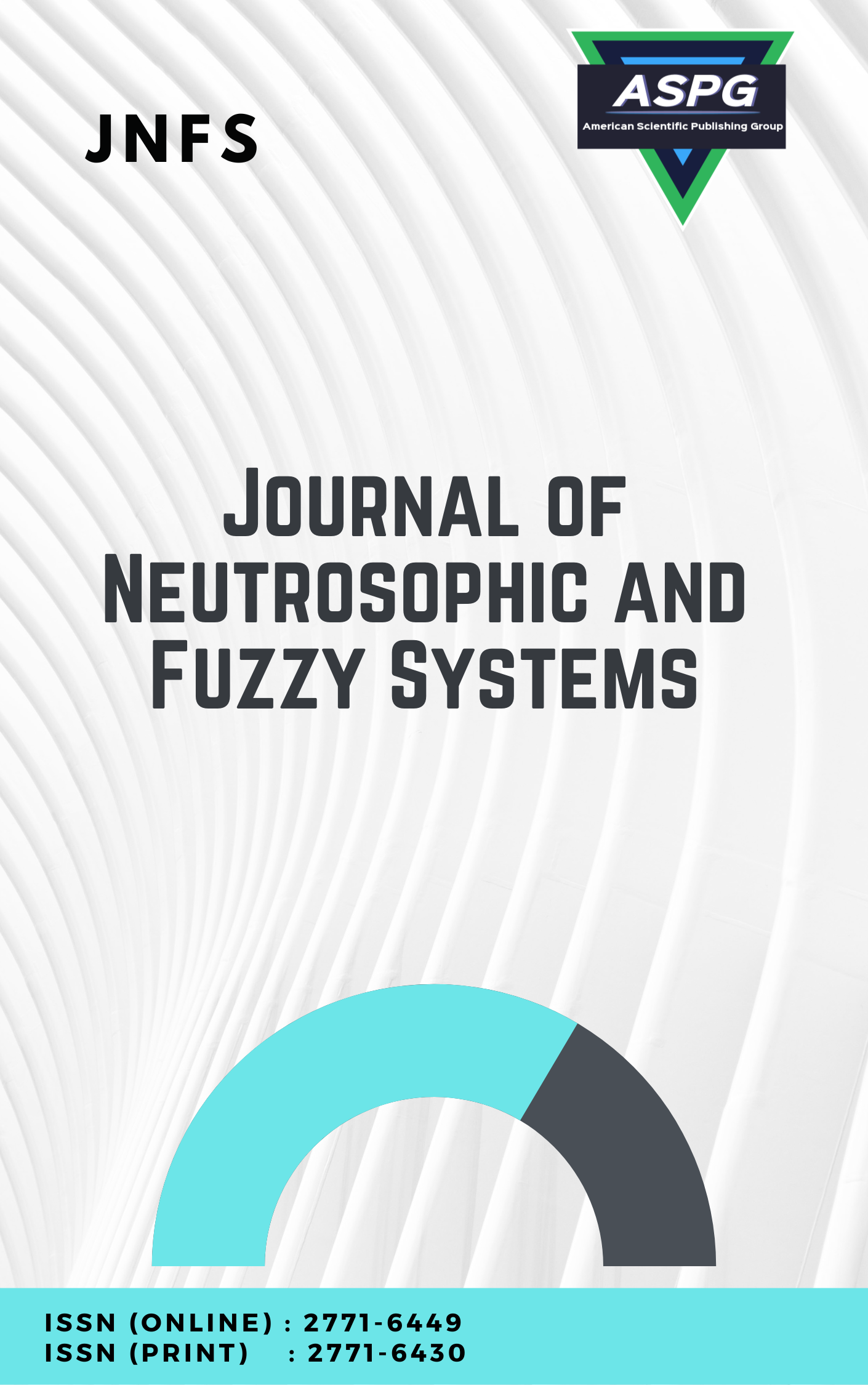

Volume 9 , Issue 1 , PP: 43-53, 2024 | Cite this article as | XML | Html | PDF | Full Length Article
Prem Kumar Singh 1 *
Doi: https://doi.org/10.54216/JNFS.090106
Recent time data representation and visualization is considered as one of the major issues. It become more crucial when the data sets exists beyond the non-euclidean geometry and its hybridization also. There are several examples given by non-euclidean geometry by Lobachevsky, Bolyai, Riemannian which contains failure of Euclid postulates V and II, respectively. The problem arises when none of the Euclid Postulates exists. It might possible that the data sets contains unknown or co-ordinate free geometry. In this case the data can be explored based on a defined vector space rather than available co-ordinate geometry. It require human Turiyam consciousness to explore these types of unknown, undefined, co-ordinate free data. To understand this problem current paper explores the Turiyam geometry and its basic for exploring the unknown or undefined data with an example.
Concept Lattice , Graph Analytics , Knowledge representation , Non-Euclidean , Turiyam Geometry , Unknown Graph
[1] Popov, M. R., “The Smarandache Non-Geometry. Abstracts of Papers Presented to the American Mathematical Society Meetings, Vol. 17, Issue 3, pp. 595, 1996.
[2] Bhattacharya S., “A model to a Smarandache Geometry”. 2004, http://fs.unm.edu/ModelToSmarandacheGeometry.pdf
[3] Kuciuk L., and Antholy M., “An introduction to the Smarandache geometries. JP Journal of Geometry & Topology”, Vol. 5, Issue 1, 77-81, 2005, http://fs.unm.edu/IntrodSmGeom.pdf
[4] Smarandache F., “NeutroGeometry & AntiGeometry are alternatives and generalizations of the Non-Euclidean Geometries”. Neutrosophic Sets and Systems, Vol. 46, pp. 456-476, 2021. http://fs.unm.edu/NSS/NeutroGeometryAntiGeometry31.pdf
[5] Singh P. K., “AntiGeometry and NeutroGeometry Characterization of Non-Euclidean Data Sets”. Journal of Neutrosophic and Fuzzy Systems, Vo 1, Issue 1, pp. 24-33, 2021, doi: https://doi.org/10.54216/JNFS.0101012
[6] Singh PK, “Data with Non-Euclidean Geometry and its Characterization”. Journal of Artificial Intelligence and Technology, Jan 2022, Volume 2, Issue 1, pp. 3-8, doi : 10.37965/jait.2021.12001
[7] Granados C., “A note on AntiGeometry and NeutroGeometry and their application to real life.” Neutrosophic Sets and Systems, Vol. 49, pp. 579-593, 2022. doi: 10.5281/zenodo.6466520
[8] Singh PK, “Non-Euclidean, Anti-Geometry and NeutroGeometry Characterization”. International Journal of Neutrosophic Sciences, Vol 18, Issue 3, pp. 8-19, 2022, doi : https://doi.org/10.54216/IJNS.180301
[9] Abraham, R. H. “Mysticism in the history of mathematics”, Progress in Biophysics and Molecular Biology, 131 (2017) 261-272.
[10] Lobachevsky N., “Pangeometry, Translator and Editor: A. Papadopoulos. Heritage of European Mathematics Series". European Mathematical Society, Vol. 4, 2010.
[11] James A. W., “Hyperbolic Geometry”. Second edition 2005, Springer. [12] Jürgen J., “Riemannian Geometry and Geometric Analysis”. Berlin: Springer-Verlag (2002)
[13] Caballero, E. G., & Smarandache, F. “Theory of Distances in NeutroGeometry”, Neutrosophic Sets and Systems, 67(1) (2024)12.
[14] DeRose, Tony D. Three-Dimensional Computer Graphics: A Coordinate-Free Approach. Retrieved 25 September 2017. [15] Deng X., and Papadimitriou C. H. (1990) Exploring an unknown graph," Journal of graph Theory, 32 (3):265-297,
[16] B. Sinclair-Desgagne, Mining for Unknown Unknowns, Available at SSRN 4426652, EPTCS 379 (2023) 507-517. https://doi.org/10.48550/arXiv.2307.05071
[17] Singh P. K. “Four-Way Turiyam based Characterization of Non-Euclidean Geometry”, Journal of Neutrosophic and Fuzzy Systems, Vol. 5 , No. 2 , pp. 69-80, Mar 2023, doi : https://doi.org/10.54216/JNFS.050207
[18] Bal M., Singh P. K., and Ahmad K. D., “A Short Introduction To The Symbolic Turiyam Vector Spaces and Complex Numbers.” Journal of Neutrosophic and Fuzzy Systems, Vol. 2, Issue 1, pp. 76-87, 2022. doi : https://doi.org/10.54216/JNFS.020107
[19] Singh P. K. , “Mathematical Concept Exploration Using Turiyam Cognition”, Galoitica: Journal of Mathematical Structures and Applications, 9(1), 2023, 08-22, https://doi.org/10.54216/GJMSA.090101
[20] Belnap J. N. , “A useful four-valued logic”. In J. Michael Dunn and George Epstein, editors, Proceedings of the Fifth International Symposium on Multiple-Valued Logic, Modern Uses of Multiple-Valued Logic. Indiana University, D. Reidel Publishing Company, pp 8-37, 1975.
[21] Font J. M., “Belnap's Four-Valued Logic and De Morgan Lattices.” In: Logic Journal of the IGPL, Vol. 5, no. 3, pp. 1-29, 1997, doi: 10.1093/jigpal/5.3.1-e.
[22] S., Four-Dimensional Space, Nature 31 (1885) 481, https://doi.org/10.1038/031481a0
[23] Ani A., Mashadi M., Sri G. "Invers Moore-Penrose pada Matriks Turiyam Simbolik Real." Jambura Journal of Mathematics 5, no. 1, pp. 95-114, 2023.
[24] R. Anggraini, Ganeralizasi eneralisasi invers pada matriks Turiyam simbolik real, URI: https://repository.unri.ac.id/handle/123456789/10983
[25] G.A. Ganati, V. N. S. R. Repalle, M.A. Ashebo, Relations in the context of Turiyam sets, BMC Research Notes, 16(1) (2023) 1-6, doi: 10.1186/s13104-023-06292-4
[26] G.A. Ganati, V. N. S. R. Repalle, M.A. Ashebo, Social network analysis by Turiyam graphs. BMC Research Notes, 16(1) (2023) 1-9, https://doi.org/10.1186/s13104-023-06435-7
[27] G.A. Ganati, V. N. S. R. Repalle, M.A. Ashebo, M. Amini, Turiyam Graphs and its Applications, Information Sciences Letters 12(6)(2023)2423, doi: 10.18576/isl/120618
[28] Singh P. K., Surathu N., Prakash G.S., “Turiyam Based Four Way Unknown Profile Characterization on Social Networks”, Journal of Galoitica: Journal of Mathematical Structures and Applications, 10 (2) (2024) 27-43
[29] Tian, L., Rao, W., Zhao, K., & Vo, H. T., “Analyzing world city network by graph convolutional networks”, Scientific Reports, 14(1) (2024) 18933.
[30] Fujita, T. Uncertain Incidence, Threshold, and Linguistic graph.
[31] Silva, Manuel. "The Latest Advances on AI and Robotics Applications." Journal of Artificial Intelligence and Technology 2, no. 4, pp. 131-131, 2022.
[32] Zhang, Z., Xu, X., Yue, F., & Ba, Y. “Robot path planning based on concept lattice”, International Journal of Approximate Reasoning, 153 (2023) 87-103.